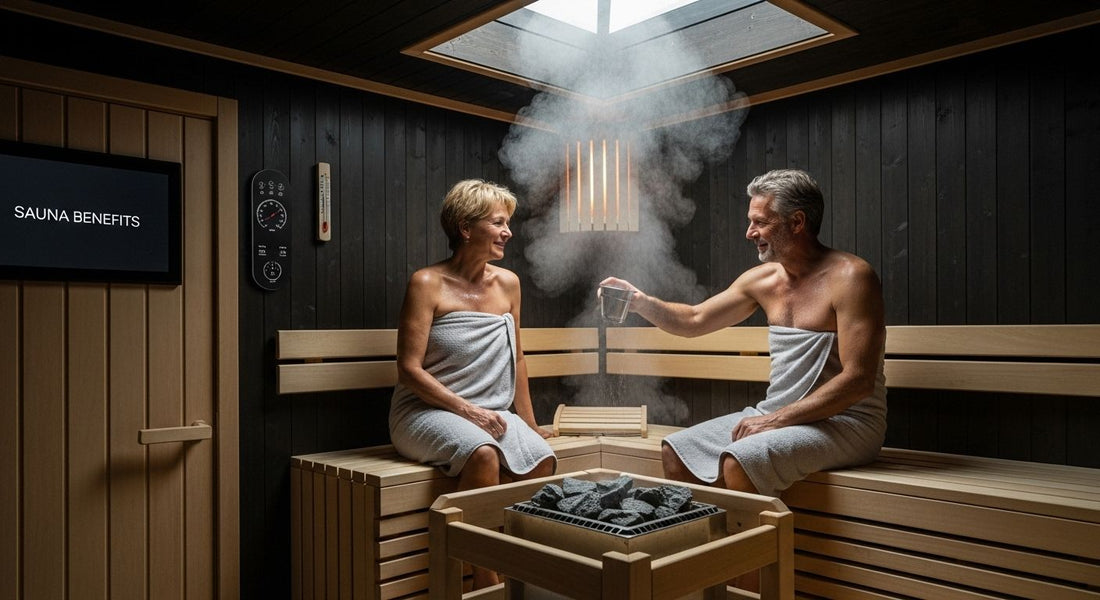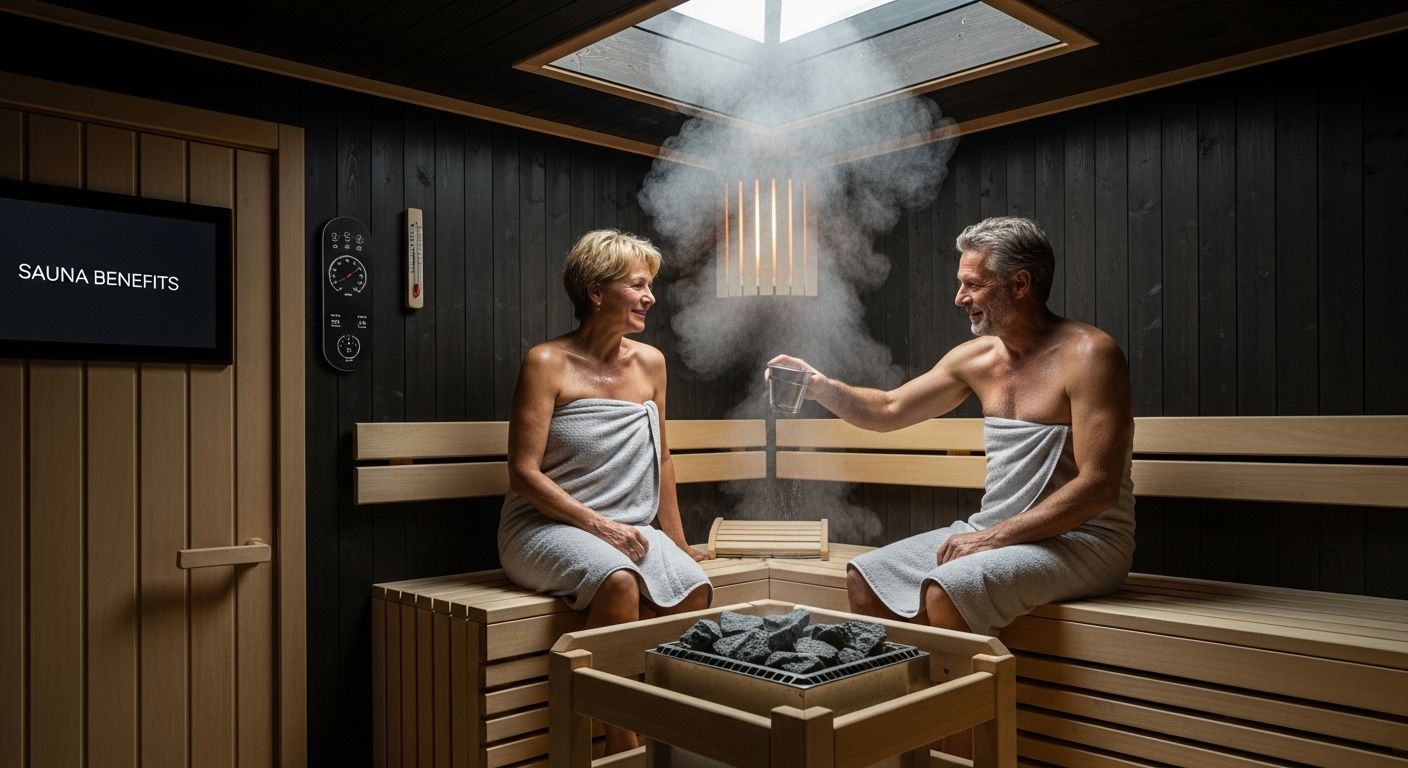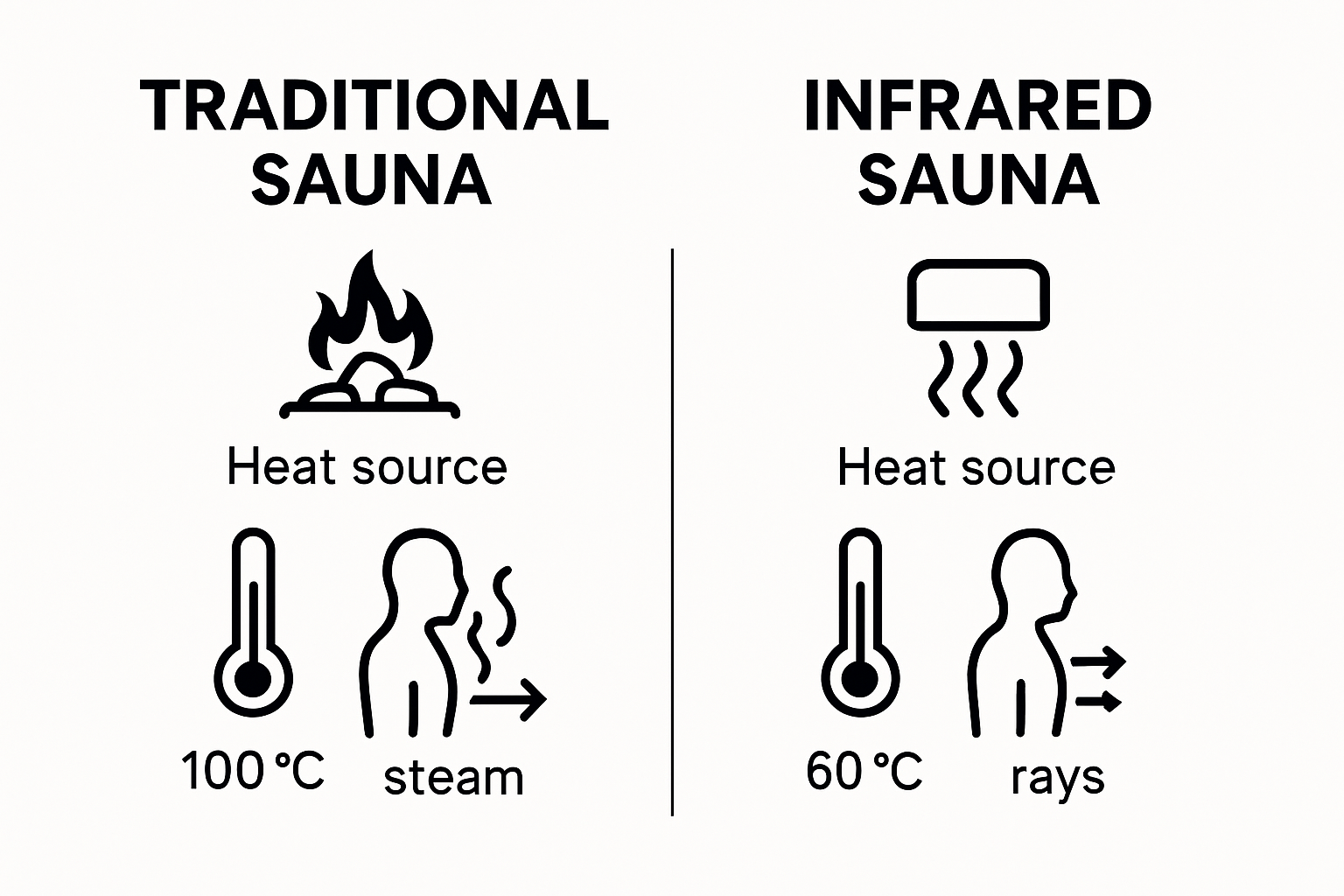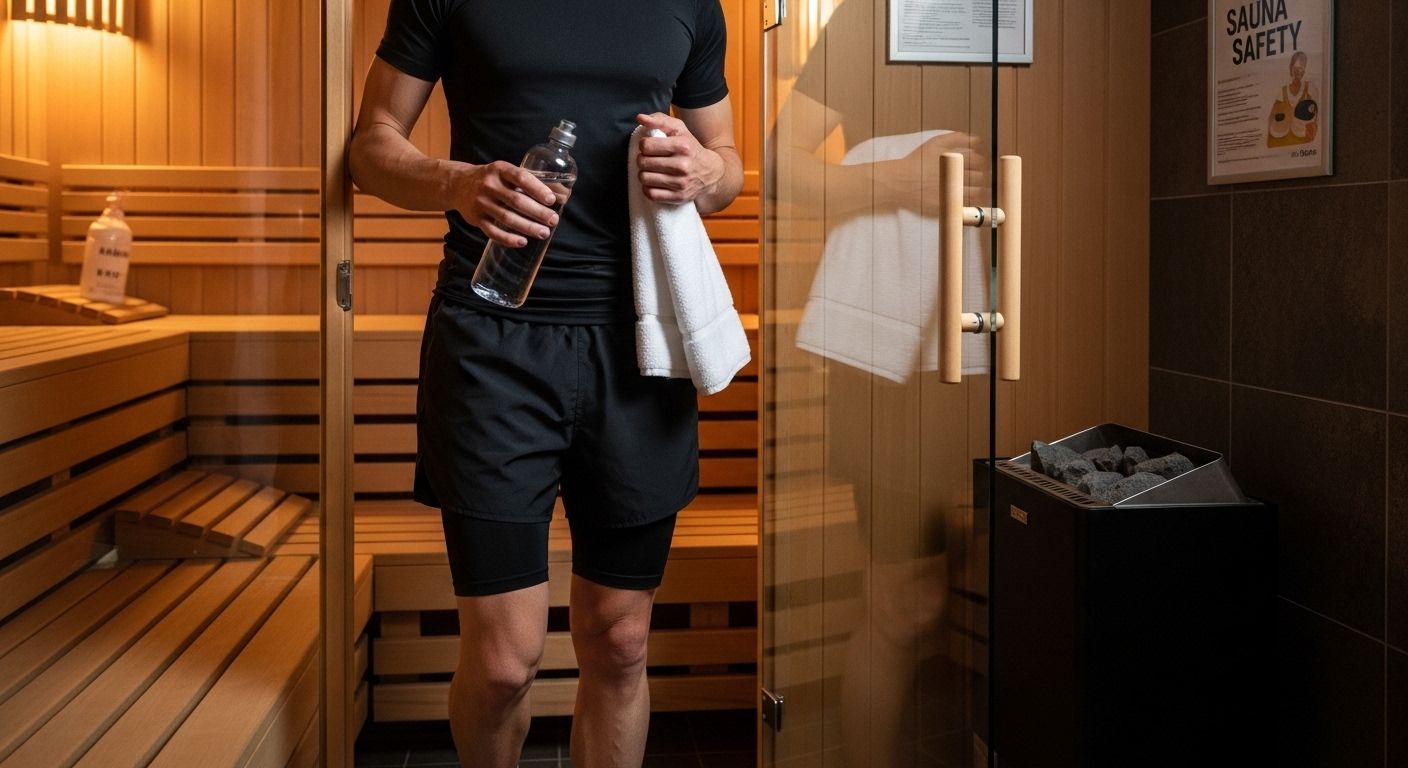
How Saunas Work: Understanding Their Benefits and Science

Saunas have steam rooms beat when it comes to sweating and stress relief. But the real surprise is just how much your body can change in a matter of minutes. Studies show that people can sweat out up to 2 liters per hour in a sauna, removing toxins while boosting circulation and heart health. You might expect a sauna to simply warm you up, but the reality is every session puts your entire system into a powerful healing mode you never see coming.
Table of Contents
- What Is A Sauna And Its Different Types?
- The Science Of Heat: How Saunas Generate Warmth
- Health Benefits Of Sauna Use: Why It Matters
- The Role Of Sweating: How The Body Cools Itself
- Understanding Safety And Best Practices For Sauna Use
Quick Summary
| Takeaway | Explanation |
|---|---|
| Traditional Finnish saunas induce intense sweating. | Practicing in traditional Finnish saunas, which reach 70 to 100 degrees Celsius, promotes sweating and health benefits through heat exposure. |
| Infrared and steam saunas offer unique benefits. | Infrared saunas heat body tissues directly, while steam rooms maintain high humidity, catering to different wellness needs. |
| Regular sauna use supports cardiovascular health. | Sauna sessions mimic moderate exercise, enhancing blood circulation and potentially lowering risks of heart disease. |
| Stay hydrated before and after sauna sessions. | Proper hydration helps maintain fluid balance in the body, essential for safe and effective sauna use. |
| Assess health conditions before sauna use. | Individuals with specific medical issues should consult healthcare professionals to ensure safe sauna participation. |
What is a Sauna and Its Different Types?
A sauna represents a specialized heated room designed to induce perspiration and provide therapeutic relaxation through controlled heat exposure. According to research from the National Institutes of Health, saunas originated in Finland but have now become a global wellness practice with various technological adaptations.
Traditional Finnish Sauna
The traditional Finnish sauna serves as the original heat therapy room, characterized by wood-lined interiors and high temperatures ranging between 70 to 100 degrees Celsius. These saunas typically use dry heat generated by a wood burning or electric stove with stones, which participants can sprinkle with water to create momentary steam bursts. The primary goal involves creating an environment that promotes intense sweating and physiological responses that support overall health.
Modern Sauna Variations
Modern sauna technology has expanded beyond traditional designs, introducing innovative heating methods and experiences:
Below is a comparison table outlining the main types of saunas, their heating methods, typical temperature ranges, and distinctive features as discussed in the article.
| Sauna Type | Heating Method | Typical Temperature | Humidity Level | Distinctive Features |
|---|---|---|---|---|
| Traditional Finnish | Wood or electric stove (with stones) | 70-100°C (158-212°F) | Low (can be raised by throwing water on stones) | Original design, wood-lined, intense dry heat |
| Infrared Sauna | Electromagnetic radiation | 40-60°C (104-140°F) | Low | Directly heats body tissues, gentle warm-up |
| Steam Room | Steam generator | Lower than Finnish saunas | High (near 100%) | Moist heat, promotes high sweating, softer atmosphere |
| Electric Sauna | Electric heating elements | Adjustable, similar to Finnish | Low to moderate | Consistent, controllable heat, modern setup |
| Outdoor Sauna | Typically wood or electric stove | Varies (depends on design) | Varies | Robust materials, external installation |
- Infrared Saunas: Utilize electromagnetic radiation to directly warm body tissues at lower temperatures (typically 40 to 60 degrees Celsius)
- Steam Rooms: Maintain nearly 100% humidity with lower temperatures compared to traditional dry saunas
- Electric Saunas: Provide consistent, controllable heat through electric heating elements
- Outdoor Saunas: Designed for external installation, often made from robust materials like cedar or pine
Physiological Benefits
Each sauna type offers unique mechanisms for delivering heat therapy. The core principle remains consistent: controlled heat exposure triggers multiple physiological responses. These include increased heart rate, enhanced blood circulation, muscle relaxation, and potential metabolic improvements. While the specific mechanisms vary between traditional and infrared models, the fundamental goal of promoting wellness through controlled heat remains unchanged.

The Science of Heat: How Saunas Generate Warmth
Saunas utilize advanced thermal transfer principles to create environments that systematically elevate body temperature and induce physiological responses. Research from PubMed reveals that these heat generation mechanisms involve complex interactions between environmental temperature, radiation energy, and human thermoregulatory systems.
Heat Generation Mechanisms
Traditional saunas generate warmth through three primary mechanisms: radiation, convection, and conduction. The heating elements such as electric stoves or wood burning units create high temperatures between 70 to 100 degrees Celsius. These heat sources warm the surrounding air and surfaces, which then transfer thermal energy to the human body through direct contact and radiant heat waves.
Thermal Transfer Principles
The thermal transfer in saunas operates through several key processes:
- Radiation: Infrared waves directly penetrate body tissues, warming internal structures without heating surrounding air
- Convection: Hot air circulates within the sauna space, creating an environment that gradually increases skin temperature
- Conduction: Direct contact with heated surfaces like wooden benches transfers thermal energy into the body
Physiological Heat Response
When exposed to intense heat, the human body activates sophisticated cooling mechanisms. As ambient temperatures rise, blood vessels dilate, increasing circulation and promoting sweating. According to Harvard Health, skin temperatures can rapidly increase to approximately 40 degrees Celsius within minutes, triggering a comprehensive physiological response designed to maintain core body temperature and prevent overheating.
Health Benefits of Sauna Use: Why It Matters
Sauna usage extends far beyond simple relaxation, offering a comprehensive range of health benefits that impact multiple physiological systems. Research from the Cleveland Clinic demonstrates that regular sauna sessions can significantly contribute to overall wellness and potentially reduce risks of various health conditions.
Cardiovascular and Circulatory Benefits
Regular sauna use triggers profound cardiovascular responses similar to moderate physical exercise. The intense heat causes blood vessels to dilate, improving circulation and reducing blood pressure. These physiological changes can enhance heart function, potentially decreasing risks of cardiovascular diseases. The body experiences increased heart rate and improved blood flow, which mimics the cardiovascular stress experienced during light to moderate physical activity.
Stress Reduction and Mental Wellness
Saunas provide powerful stress management mechanisms through multiple pathways:
- Hormonal Regulation: Heat exposure stimulates endorphin production, promoting natural stress relief
- Muscle Relaxation: Warmth helps release physical tension and reduce muscular stress
- Neurological Calm: The quiet, controlled environment supports mental decompression
Comprehensive Health Improvements
Beyond immediate relaxation, consistent sauna use offers long term health advantages. According to Harvard Health, potential benefits include improved immune function, reduced inflammation, enhanced skin health, and potential neurological protection. The controlled heat exposure appears to stimulate cellular repair mechanisms, support metabolic processes, and potentially contribute to increased longevity by reducing systemic inflammation and supporting cardiovascular health.
The Role of Sweating: How the Body Cools Itself
Sweating represents a sophisticated biological mechanism designed to regulate body temperature and maintain physiological equilibrium. Research from PubMed reveals that this complex process is fundamental to human survival, allowing organisms to manage heat stress through precise thermoregulatory responses.
Sweat Production Mechanism
The human body contains approximately 2-4 million sweat glands distributed across the skin surface, with two primary types: eccrine and apocrine glands. Eccrine glands, concentrated on the forehead, palms, and soles, produce a watery fluid that efficiently facilitates heat dissipation. When body temperature rises, the hypothalamus triggers these glands to release sweat, initiating the body’s cooling process through evaporative heat loss.
This table summarizes the physiological process of sweating as a response to sauna heat, highlighting each key stage and its function.
| Stage | Description | Function |
|---|---|---|
| Heat Detection | Thermoreceptors in skin and brain sense temperature | Initiates body’s cooling response |
| Neural Signaling | Hypothalamus activates sweat glands | Coordinates sweat production |
| Fluid Secretion | Sweat glands release moisture to skin surface | Enables evaporative cooling |
| Evaporative Cooling | Sweat evaporates from skin | Removes heat from body, lowers temperature |
| Toxin Elimination | Sweating out water and solutes | Assists removal of some toxins and electrolytes |
Thermoregulatory Process
Sweating operates through several critical physiological stages:
- Heat Detection: Thermoreceptors in the skin and brain identify temperature changes
- Neural Signaling: The hypothalamus coordinates sweat gland activation
- Fluid Secretion: Sweat glands release moisture to the skin surface
- Evaporative Cooling: Liquid transforms into vapor, extracting heat from the body
Physiological Significance
Beyond temperature regulation, sweating serves multiple health functions. According to Harvard Medical School, the process helps eliminate toxins, supports immune function, and maintains electrolyte balance. During intense heat exposure, such as in saunas, the body can produce up to 2 liters of sweat per hour, demonstrating the remarkable efficiency of this natural cooling system.
Understanding Safety and Best Practices for Sauna Use
Sauna bathing offers numerous health benefits, but responsible usage requires understanding potential risks and implementing appropriate safety protocols. The Mayo Clinic emphasizes the importance of informed and cautious sauna participation to maximize wellness potential while minimizing potential health complications.
Medical Considerations and Risk Assessment
Prior to beginning regular sauna sessions, individuals should conduct a comprehensive health evaluation. Certain medical conditions can significantly impact sauna safety, including cardiovascular disorders, hypertension, and respiratory challenges. People with chronic health issues, pregnant women, and individuals taking medications that affect temperature regulation should consult healthcare professionals before incorporating sauna therapy into their wellness routine.
Hydration and Physiological Preparation
Optimal sauna experience requires strategic physical preparation:
- Pre Hydration: Drink water before entering the sauna to support bodily fluid balance
- Moderate Duration: Limit initial sessions to 10 15 minutes, gradually increasing tolerance
- Post Session Recovery: Rehydrate and allow body temperature to normalize
- Clothing Considerations: Wear minimal, breathable clothing or use appropriate towel coverings
Safe Sauna Practices
Responsible sauna use involves implementing critical safety strategies. Avoid alcohol consumption before or during sauna sessions, as it can impair the body’s natural cooling mechanisms and increase risk of dehydration. Monitor personal physical responses, exit immediately if experiencing dizziness, nausea, or extreme discomfort. Individuals with pre existing health conditions should seek medical guidance and potentially use lower temperatures or shorter duration sessions to ensure personal safety.

Experience the Science-Backed Power of Saunas with Best Life Sauna
Are you ready to turn proven health benefits into your daily reality? After learning how controlled heat, sweating, and tailored sauna experiences can support your heart, relieve stress, and boost your overall wellness, it is time to choose solutions truly designed for you. Many people struggle to find saunas that offer both authentic results and comfort at home. At Best Life Sauna, you can discover a curated selection of premium options. From innovative infrared saunas for targeted heat therapy to traditional Finnish and outdoor designs that maximize relaxation, everything is backed by trusted science and enthusiastic customer reviews. Join countless wellness enthusiasts who have already found their path to better circulation, smoother recovery, and deeper calm.

Why wait for better health and peace of mind? Visit Best Life Sauna today to explore our full range of high-performance sauna products and accessories. Take advantage of free shipping on orders over $200, our price match guarantee, and a user-friendly experience that puts your needs first. Step into wellness now and let your best life begin.
Frequently Asked Questions
What are the main types of saunas?
The main types of saunas include traditional Finnish saunas, infrared saunas, steam rooms, electric saunas, and outdoor saunas, each with different heating methods and humidity levels.
How do saunas promote sweating and relaxation?
Saunas promote sweating and relaxation through controlled heat exposure, which increases body temperature, dilates blood vessels, and activates the body’s cooling mechanism, leading to increased perspiration and muscle relaxation.
What health benefits are associated with regular sauna use?
Regular sauna use is associated with cardiovascular benefits, stress reduction, improved immunity, enhanced skin health, and potential metabolic improvements, akin to the effects of moderate physical exercise.
Are there any health risks associated with using a sauna?
Yes, individuals with certain health conditions, such as cardiovascular disorders or respiratory issues, should consult a healthcare professional before using a sauna. Staying hydrated and limiting session duration can help mitigate risks.

